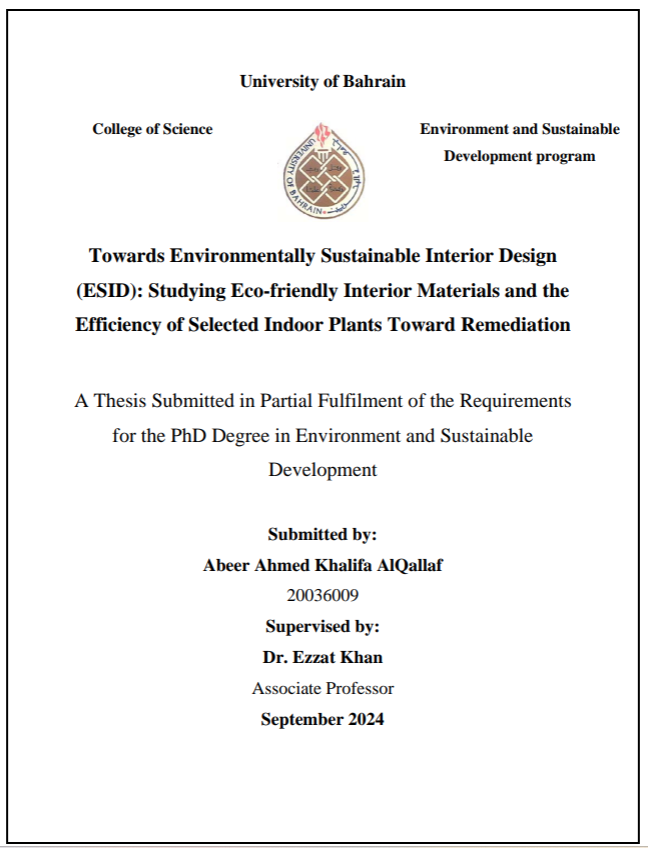وثيقة
المعرف
https://digitalrepository.uob.edu.bh/id/a05bbc45-e73c-4838-a0f6-a7c9f3526e66
Towards Environmentally Sustainable Interior Design (ESID): Studying Eco-friendly Interior Materials and the Efficiency of Selected Indoor Plants Toward Remediation
وكيل مرتبط
Khan, Ezzat, مشرف الرسالة العلمية
تاريخ النشر
2024
اللغة
الإنجليزية الوسطى (1100-1500)
مدى
[1]. 15. 179. [1] pages
مكان المؤسسة
Sakhir, Bahrain
نوع الرسالة الجامعية
Thesis (Master)
الملخص الإنجليزي
Abstract:
In recent years, there has been a noticeable trend in the interior design sector towards creating
interior-built environments that prioritize both health and sustainability. This shift, termed as
environmentally sustainable interior design (ESID), depends heavily on the careful selection of
eco-friendly interior materials (EFIMs) and suitable indoor plants. Consequently, the study was
conducted on EFIMs available in the local market of Bahrain. A sample of n=30 local stores
supplying interior finishing materials was selected for the study. Data were collected via five
methods. Firstly, a review of existing EFIMs. Secondly, the availability of EFIMs was observed
through a non-participatory approach. Thirdly, a survey of EFIMs supplied in the Bahraini market
was also carried out. Fourth, a semi-structured interview with retailers, final and fifth, semi-
structured interview with local interior designers was scheduled. Data were collected and
processed using Microsoft Excel program. In the context of phytoremediation, formaldehyde
purification experiments have been performed by selecting three indoor non-native plants namely,
Epipremnum aureum (Pothos plant), Chlorophytum comosum (Spider plant), and Spathiphyllum
wallisii (Peace lily). Sensors and real-time instruments IQ-610 direct sense probe was used. Data
were processed and statistical analysis (ANOVA test) has been performed for the data. The results
of the EFIMs study show 70% of suppliers have stocked EFIMs with a total of sixty-three EFIMs
which were collected and identified. Among them, 67% of EFIMs were categorized as flooring
finishes followed by wall finishes (25%) and ceiling finishes (8%). The majority (80%) of the
interviewed interior designers did not use EFIMs and stated that their clients did not request EFIMs
for their projects. All the interviewed interior designer agreed that clients are not aware of the
importance of EFIMs. The results of the HCHO phytoremediation experiments for single potted
plants revealed that the most efficient plant was S. wallisii, followed by E. aureum, and C.
comosum 73.0, 71.5, and 71%, respectively. While the HCHO phytoremediation for 2 identical
potted plants revealed that the most efficient plant was E. aureum, followed by S. wallisii, and C.
comosum 77.5, 74.6, and 73.0%, respectively. It is recommended to continuously design, and
supply EFIMs, to initiate awareness programs for public, and to include EFIMs knowledge in
educational curriculums. Interior designers are recommended to search and apply updated EFIMs
in their projects. It was also recommended to test similar plants in real environments for a long
time and expose them to different air pollutants.
المجموعة
قالب العنصر
أطروحات

